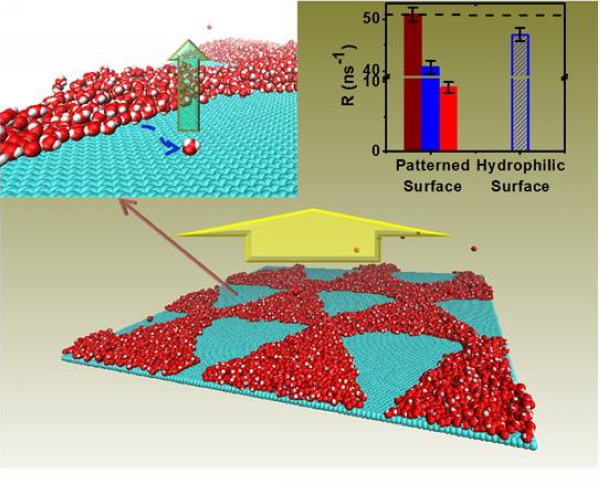Enhancement of water evaporation on solid surfaces with nanoscale hydrophobic-hydrophilic patterns
The evaporation of water is of fundamental importance in many processes in nature and industry, e.g., transpiration, thermoregulation, water circulation, curing, printing and even the survival of bacteria. There is usually a tiny and even nanoscale volume of water on various biological and material surfaces, such as the surfaces of leaf, soil and even bacteria, and most of these surfaces have hydrophobic-hydrophilic patterns. The evaporation of nanoscale water on these surfaces will cause distinct effects, e.g., plant withering, desertification, and bacterial sterilization.
Dr. Rongzheng Wan, Prof. Haiping Fang and his team, together with Prof. Guoquan Zhou from Zhejiang A&F University, employed a nanoscale triangular hydrophobic-hydrophilic pattern as a model to study the evaporation of water on a patterned surface by molecular dynamics (MD) simulations. The results showed that the evaporation of a nanoscale volume of water from certain hydrophobic-hydrophilic patterns is faster than that from any surface with uniform wettability. The physics behind lies in that, the considerable evaporation from the hydrophobic region, where water originates from the hydrophilic region by diffusing across the contact lines, exceeds the slight decrease of evaporation from the hydrophilic region. These findings provide a fundamental understanding of water evaporation on nanoscale-patterned surfaces, and also lead to potential applications for regulating the evaporation of nanoscale water on a solid surface. The results have been published in Physical Review Letters (PRL 115, 195901(2015)).

Figure 1: Enhancement of water evaporation on solid surfaces with nanoscale hydrophobic-hydrophilic patterns.
This work is based on the collaboration of the researchers from Shanghai Institute of Applied Physics, CAS and Zhejiang A&F University. It is supported by the Chinese Academy of Sciences, National Natural Science Foundation of China, the Computer Network Information Center of Chinese Academy of Sciences and the Shanghai Supercomputer Center of China.
Contact
Fang Haiping
Shanghai Institute of Applied Physics(SINAP),CAS
E-mail: fanghaiping@sinap.ac.cn 
